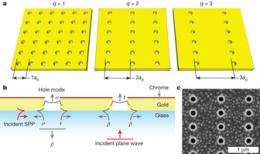December 20, 2012 report
New experiment helps explain extraordinary optical transmission

(Phys.org)—An international team of researchers working in the Netherlands has conducted an experiment that sheds new light on the phenomenon known as Extraordinary Optical Transmission (EOT)—where light is able to shine through a metal with holes in it that are smaller than the light waves themselves. In their paper published in the journal Nature, the team describes how they adjusted the distance between the holes while keeping the wavelength of light constant and in so doing discovered the degree to which two different waveforms impact the metal's transmission properties.
EOP occurs when researchers drill very small holes in a very thin metal plate and then shine a light on it. Despite the fact that the holes should be too small to allow light to pass through, they appear to do so anyway. Scientists attributed this phenomenon to plasmonics—a strong paring between the incident light field and the motion of free electrons along the surface of the metal. What happens, they say, is that light striking free electrons on the surface of the metal cause a stream of electron motion that moves along the surface. When a hole is encountered, the plasmons move through the hole causing glowing to occur on the other side, which is perceived as the original light.
Subsequent research showed however, that plasmonics alone could not explain the phenomenon. Drilling a single hole with the same volume as the total of all the little ones resulted in less light being emitted on the other side, for example; making the metal thinner did the same (it was later discovered that the thinner metal was not actually allowing more light through, but instead was allowing electrons on the opposite of the metal to be excited by the photons directly). This led to the idea that another waveform was involved—quasi-cylindrical waves (QCW)—which is where electrons behave differently near the holes, because they are there. What was not well understood however, was the degree to which each impacted the overall properties of EOT.
To find out, the researchers drilled holes in several identical metal plates. The holes were spaced the same vertically but varied by very small amounts horizontally. By flashing light of the same wavelength on each of the plates and noting how much light passed through the holes compared to the other plates, the researchers were able to measure the degree to which each type of waveform was impacting the amount of light that was emitted out the other side.
Besides increasing understanding of how EOP works in general, this new work will likely result in improvements in the development of devices that rely on its unique properties.
More information: Quasi-cylindrical wave contribution in experiments on extraordinary optical transmission, Nature, 492, 411–414 (20 December 2012) doi:10.1038/nature11669
Abstract
A metal film perforated by a regular array of subwavelength holes shows unexpectedly large transmission at particular wavelengths, a phenomenon known as the extraordinary optical transmission (EOT) of metal hole arrays. EOT was first attributed to surface plasmon polaritons, stimulating a renewed interest in plasmonics and metallic surfaces with subwavelength features. Experiments soon revealed that the field diffracted at a hole or slit is not a surface plasmon polariton mode alone. Further theoretical analysis predicted that the extra contribution, from quasi-cylindrical waves, also affects EOT. Here we report the experimental demonstration of the relative importance of surface plasmon polaritons and quasi-cylindrical waves in EOT by considering hole arrays of different hole densities. From the measured transmission spectra, we determine microscopic scattering parameters which allow us to show that quasi-cylindrical waves affect EOT only for high densities, when the hole spacing is roughly one wavelength. Apart from providing a deeper understanding of EOT, the determination of microscopic scattering parameters from the measurement of macroscopic optical properties paves the way to novel design strategies.
Journal information: Nature
© 2012 Phys.org



















